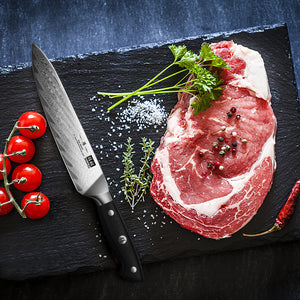
What is a Kitchen Utility Knife?
A kitchen utility knife is an extremely useful tool to have around the kitchen. Since there are so many different types of knives, it can be hard to discern which knife is best suited for which purpose. This is a complete guide to utility knife kitchen, so after reading this, you can instantly identify a utility kitchen knife and use it correctly.
A utility knife is a lightweight knife that typically has a smaller blade compared to some other types of knives. The utility knife kitchen is anywhere between 4 to 7 inches long. This makes it slightly larger than a paring knife but much smaller than other types of knives, like a carving knife or a bread knife. The blade of a utility knife can either be straight-edged or serrated. Since it is smaller in size, a utility knife is perfect for chopping vegetables or fruits and doing detailed cutting if necessary. The small size provides more control and makes it easier for the user to cut more precisely.
What is a Utility Knife Used for in the Kitchen?
A utility knife kitchen is a very versatile knife that has multiple uses around the kitchen. This is one knife that you must have in your kitchen since it has so many uses. Here are just some of the uses of a utility knife kitchen:
- Using a Utility Knife for Cheeses
Slicing or cutting up cheese can be a challenge. This is particularly true for cheeses that are soft and require a sharp, thin blade for a clean, even cut. A utility knife is perfect for the job since it has a blade that is sharp and thin enough to get very thin slices without causing the cheese to crumble or break. It is easy to maneuver the knife over soft surfaces like cheeses.
- To Slice Meat Chubs (Salami, Summer Sausage, Etc.)
While uncooked meat requires a much sharper and larger knife, a utility knife is great for slicing and dicing tender cuts of meat. Whether it be cooked chicken breasts, salami, sausages, or any other kind of cooked meat, a utility knife can easily get the most precise cuts.
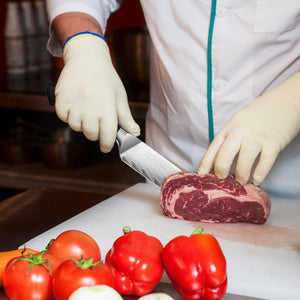
- As a Backup Steak Knife (Our Favorite!)
Speaking of cooked meats, you can substitute a utility knife for a steak knife. A steak knife is used specifically for cutting through steak and since a utility knife works perfectly on cooked meats, using it in place of a steak knife makes sense.
- To Make Veggie Slices (Cucumbers, Zucchini, and Other Squashes)
Utility knife kitchens are used for cutting up vegetables since it is the perfect in-between knife that is just the right size for most vegetables. While a paring knife may be too small for vegetables such as potatoes or squash, and a chef's knife may be too big for vegetables like green chilies, a utility knife strikes a balance. Cutting up slices is easy with a utility knife since it allows for greater control.

- To Trim Chicken or Fish
A utility knife kitchen is sharp enough to trim off fish and chicken. While raw meat is tougher and requires a sturdier blade, poultry is easier to cut, and a utility knife works just as well.
- Slicing Long, Thin Vegetables (Think Green Beans, Celery, Green Onions, Etc.)
The thin blade of a utility knife kitchen means that you can cut very long and thin vegetables without breaking a sweat. Green beans, celery, and green onions do not fare well when cut with a denser blade. Using a utility knife on such vegetables provides great results.
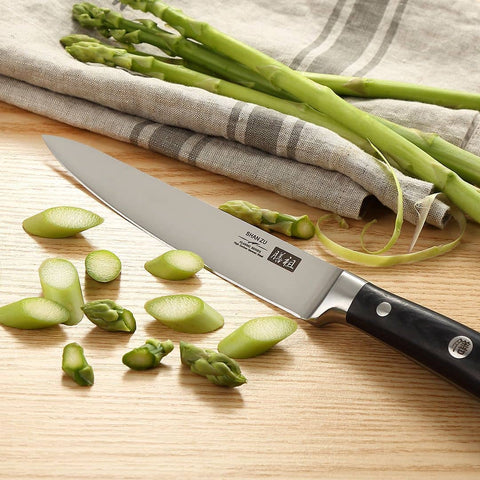
- To Cut Up Citrus (Lemons, Limes, Grapefruit)
Some citrus fruits have pretty tough skin and can be a pain to peel. A utility knife can be used to peel and cut any kind of citrus fruit, from lemons and limes to tangerines and grapefruits. A paring knife may prove too small for larger citrus fruits, so if you want a single knife for all kinds of fruits, then a utility knife is the best. You can even use the sharp point of the knife to remove the seeds.
- As a Sandwich Knife
The moderate size of a utility knife kitchen makes it a great knife to have for making sandwiches. A good sandwich knife should be large enough to cover the entire slice of bread. But small enough to be easy to hold and use.
- Slicing sandwiches
Not only is a utility knife good for making sandwiches, but also for cutting and slicing them. This is especially true if you own a serrated utility knife since the edge is suited perfectly for cutting through bread without applying much pressure and ruining the piece of bread.
Why You Need A Good Utility Knife?
If there is just one knife you have to keep in your kitchen, then it should be a utility knife. This is primarily due to its multifunctional use. As already mentioned, a utility knife kitchen is very handy around the kitchen since it can be used for everything from slicing up bread to dicing up fruits and vegetables and even cutting tenderized meat.
A paring knife is far too small and is only good for cutting small fruits and vegetables and for doing detailed work. On the other hand, a chef's knife is much larger and is not easy to use, especially if you are an amateur cook. A utility knife is a perfect middle, and this makes it a true kitchen essential.
What To Look For In A Utility Knife?
Buying a knife is an investment, not just in terms of money but also in time and effort. Finding a good utility knife is important if you are to enjoy your time in the kitchen since no one wants to deal with a knife that is a hassle to use.
There are certain key features you need to look for when looking for a utility knife. The first one is the length. A utility knife typically is between 4 to 7 inches long; anything shorter or longer than this length will be too uncomfortable to use. The next characteristic is the weight of the knife. It should have a good weight to it. It should not be so heavy that it is difficult to hold and use, but the weight helps distribute the pressure and use the blade. It is never ideal to have a knife that is too heavy or light; it should be suited to what you can use comfortably over an extended period.
When it comes to the material of the blade, then stainless steel is hands down the best option. Always look for a high-quality stainless steel blade, as it is strong, durable, and does not rust or dull easily. Stainless steel is also hygienic as it can be cleaned easily.
Finally comes the handle. The handle should be one that comfortably fits in your hand. Try to hold and apply some pressure when holding the handle to test out how it feels. A simpler handle with few curves is good. You can even get utility knives that have ergonomically designed handles if you are willing to invest.
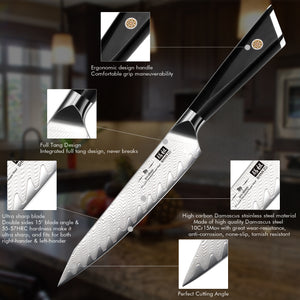
Shanzu Best Utility Knives
If you are looking for the best utility knife to add to your kitchen, then Shanzu has the best blades out there. The company makes all kinds of knives that are used by everyone from home cooks to professionals. Shanzu uses Damascus steel in its knives which adds to the longevity and functionality of its knives.
Their utility knife kitchen is made with exceptional finesse and skill. The professional quality knife is made with Japanese AUS-10V high carbon stainless steel that is rust and corrosion-resistant. It is a sturdy blade that is extremely thin and allows for maximum flexibility.
Shanzu utility knife is made up of a staggering 66 layers of stainless steel and has an ergonomically designed handle for an effortless and comfortable grip. The handle is a unique triangular shape that fits ideally in the fist and is made up of a high-pressure, fiberglass laminate. The handle is durable and can be cleaned easily. So, if you are searching for a good utility knife and want one that will last you through the years, then the Shanzu utility knife is the best option.
How to Care for a Kitchen Utility Knife?
Utility knives require much the same care and maintenance as do other kinds of knives. The cardinal rule of knife care is never keeping it wet. Always dry the knife with a soft clean towel. Never keep the knife soaked in water for long. Keep the knife clean and dry, and avoid using any abrasive materials to clean the knife, like a rough sponge. Try to clean the knife by hand and do not put it in the dishwasher.
If you are getting a utility knife kitchen that has a high carbon content, then you need to be extra careful. Knives with carbon steel are preferred but remember that these can be more reactive to acids compared to normal steel. If you use citrus fruits or other foods high in acid content, then be sure to clean the knife immediately after use to prevent the acid from diminishing the integrity of the blade.
To increase the longevity of the knife and improve its functionality applying a tiny amount of oil to the blade is good. Doing so at regular intervals keeps your utility knife from getting corroded or rusted. Use a kitchen towel to apply the oil evenly along the edge for the best results.
How to Sharpen a Utility Knife?
Keeping a knife sharpened is critical, as a dull blade is not good for cutting. A dull blade also results in more pressure being put on the blade, which can ultimately make the blade bend or become crooked. You can always get your knife sharpened by an expert. However, doing it yourself is simple enough as well.
Firstly, ensure that the utility knife is completely clean. There should be no food particles of any sort on the knife. Second, get a sharpening stone and hold the knife at an angle of 20 degrees to the stone and start pushing the knife backward and forwards. Start with sharpening the coarse edge and then move on the smooth edge. Once you are happy with the amount of sharpening, you can test out the sharpness of the blade during the process; you can clean the knife now. Clean with water and end finish off the process by applying a little oil to add a layer of protection to the blade.
We do not recommend using automatic sharpening devices as they usually involve abrasive surfaces, which can damage the blade.
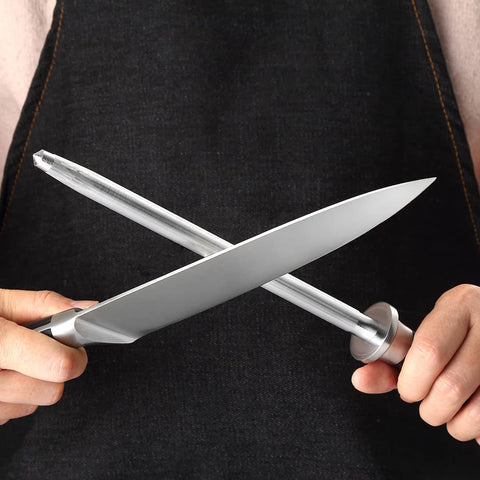
Once sharpened, you can maintain the edge of the utility knife by using a honing rod. These are great for getting rid of microscopic particles and keeping the edge even. A honing rod can also be used to help maintain the sharpness of the blade, so you do not have to sharpen it with a stone regularly.
FAQs
1. What is the difference between a paring knife and a utility knife?
A paring knife is smaller than a utility knife. The blade of a paring knife is just 3 to 4 inches in length since it is mostly used for removing the outer skin of fruits and vegetables. A utility knife is typically anywhere between 4 to 7 inches in length and can be used for cutting a variety of things.
2. What is the Difference Between Chef Knife and Utility Knife?
Compared to a chef's knife, a utility knife is more compact. Chef's knives are generally 6 to 12 inches in length. Chef knives also do not come in a serrated edge option, as do utility knives. The major difference pertains to their size, and a chef's knife is more suitable for larger fruits and vegetables as well as cooked meat cuts.
3. How long should a utility knife be?
A utility knife can be between 4 to 7 inches in length. The ideal length depends upon the individual. If you prefer a utility knife that is 5 inches long, then you should go for that length. It all boils down to personal comfort and individual preference.
4. What other utility knives are out there?
Aside from variation in size, utility knives also come in different blade edge options. You can get a utility knife kitchen with a straight edge, or you could go for one that has a serrated edge. When it comes to the material, you can select a knife that has a stainless steel blade or a high carbon steel blade. High carbon steel is much more durable and long-lasting.
5. What kind of utility knives do Michelin chefs use?
Michelin star chefs use only the best knives in the market, and utility knives are no different. Many chefs prefer knives of Japanese origin since these are made with a lot of finesse and expertise. Japanese knives are generally lightweight and are excellent for more detailed and precise cutting. Chefs go for knives that are high quality, have a nice weight to them, are made of durable materials, and are sharp.
6. Do I Need a Utility Knife In My Kitchen?
Absolutely. A utility knife is multifunctional and can be used in a variety of ways. It is an excellent addition to any kitchen. Even if you are someone who only cooks occasionally, having a utility knife at hand will prove extremely useful. If there is one knife you should get for your kitchen, it is the utility knife.


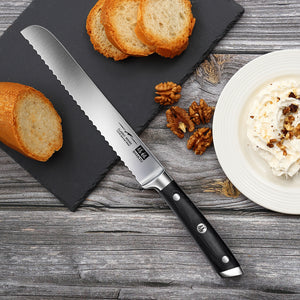


Commentaires (0)
Il n'y a pas de commentaires pour cet article. Soyez le premier à laisser un message !